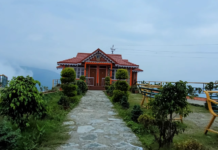Mukutmanipur Dam Tourism: A Detailed Guide for You – Bankura, West Bengal
Location: Mukutmanipur, situated in the district of Bankura, West Bengal, is renowned for the Mukutmanipur Dam, the largest earth reservoir constructed in the mid-1950s to facilitate irrigation for farmers in India. Spanning over an impressive area of 800 square kilometers, Mukutmanipur is a hidden gem enveloped by lush green forests and picturesque hillocks. The Mukutmanipur Dam stands as the second-largest dam in India.
Distances from Major Locations:
- Bankura Bus Stand: Approximately 50km via SH-2
- Kharagpur: Approximately 130km via SH-5
- Kolkata: Approximately 245km via NH-16
Google Map: Mukutmanipur Dam
The success of Mukutmanipur Dam tourism owes much to its captivating vistas, attracting tourists repeatedly to this scenic picnic spot. Additionally, Mukutmanipur is renowned for its delectable local Bengali cuisines served in various eateries across the city.
About Mukutmanipur Dam:
Mukutmanipur is approximately 120 km away from my residence. Despite Bankura not being a widely recognized name, it boasts numerous heritage sites of historical significance. The city lies just 250 km away from Kolkata. Notably, Bishnupur, located in the Bankura district, is celebrated for its Terracotta temples associated with the Malla dynasty. Mukutmanipur Dam has awaited UNESCO’s World Heritage declaration for the past two decades. Built on the Kangsabati River coursing through the district, the dam serves both irrigation and industrial purposes.
While dams are primarily constructed for industrial reasons, some, like Mukutmanipur, inadvertently evolve into tourist attractions. Noteworthy dams like Tehri, Bhakra-Nangal, Hirakud, and Nagarjuna-Sagar draw substantial tourist footfalls, despite their original purpose not being tourism.
Attractions in Mukutmanipur:
- Kangsabati Dam: The second-largest earthen dam in India, stretching 11 kilometers in length, offers serene views amidst enchanting natural surroundings. Built during the tenure of Bengal’s former Chief Minister, Dr. Bidhan Chandra Roy.
- Musafirana Viewpoint: Experience the mesmerizing sight of a Moonrise atop a hillock at Musafirana Viewpoint.
- Paresh Nath Shiv Mandir: An open temple dedicated to Mahadev, revered as a sacred site by locals. The idol unearthed during the dam’s construction is believed to signify Jain’s cultural heritage.
- Deer Park: Bonpukuria Deer Park provides an idyllic setting for family outings, where nature’s tranquility harmonizes with the playful presence of deer.
- Noadihi Sunset Point: A serene spot after Baroghutu, offering a rejuvenating ambiance amidst nature’s silence, complemented by a breathtaking sunset view.
- Ambika Temple: Situated in Ambikanagar village, the temple has been a center of worship for Goddess Durga as Maa Ambika for over 700 years.
Accommodation Options:
Mukutmanipur offers various accommodation options including government residences, youth hostels, lodges, and hotels with restaurants. Local transport facilities such as autorickshaws and cycle rickshaws are available for tourists.
Tourist Places in and around Mukutmanipur:
Approximately 2 km from the dam lies Banpukuria Deer Park, home to diverse bird and animal species. Mukutmanipur and the nearby Jhilimili attract over 100,000 tourists annually, drawn to the spectacular views of the dam throughout the day.
How to Reach:
Mukutmanipur is well-connected by both road and rail networks.
Weather: The climate in Mukutmanipur is characterized by hot and humid conditions.
Best Time to Visit: The optimal time to explore Mukutmanipur is from October to March.
Mukutmanipur stands as an ideal retreat where the second-largest earthen dam in India is ensconced amidst mystical hillocks resembling a majestic crown or “Mukut,” adorned by the necklace-shaped dam in the verdant expanse of “Rangamati.”
Official Website: Bankura Tourism










